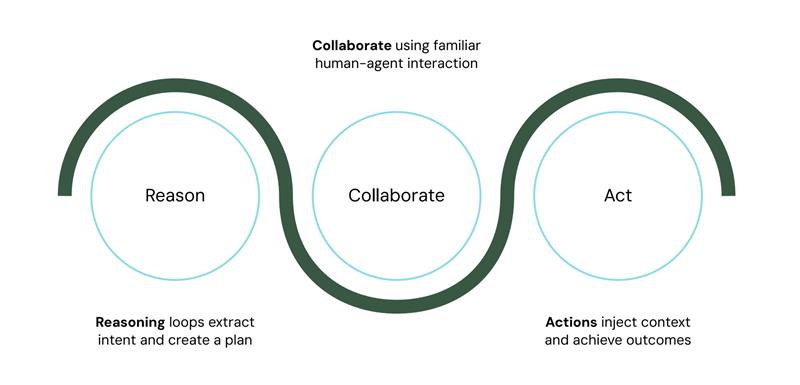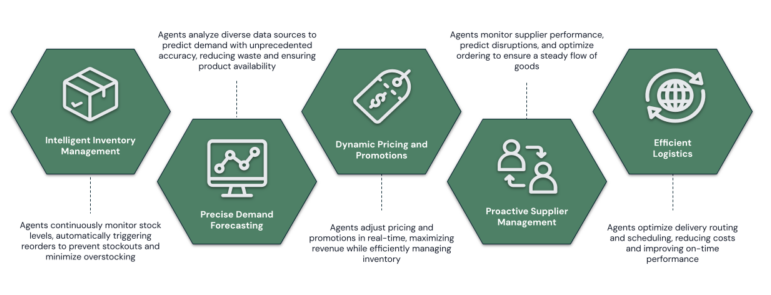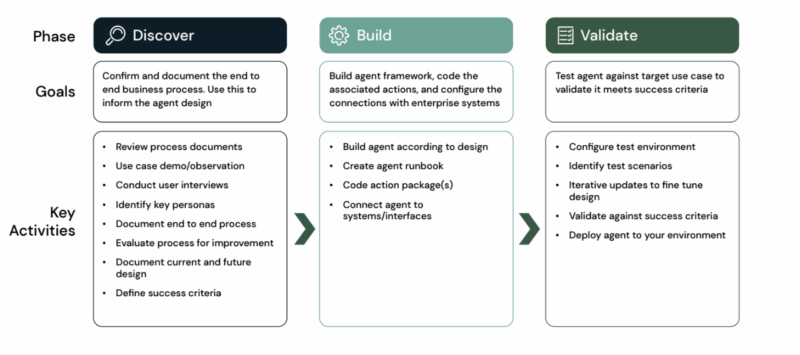Table of Contents:
- What is agentic AI?
- How agentic AI works: inside the architecture of autonomous systems
- Agentic AI vs. chatbots and traditional AI: what’s the difference?
- How enterprises are using agentic AI today
- The enterprise benefits of agentic AI systems
- Managing risk and governance in agentic AI deployment
- Getting started with agentic AI: first steps for enterprise teams
- The future of enterprise automation: embracing agentic AI
Enterprise AI agents: the future of work
Agentic AI marks a shift in enterprise tech that moves from systems that follow commands to intelligent agents that reason, collaborate, and act on their own. Unlike traditional automation or generative AI, these agents operate independently to pursue business goals. With 73% of enterprise leaders exploring these systems[1], thinking about implementing AI agents, agentic AI is becoming a key driver of transformation that is advancing the technology far beyond legacy RPA. For IT leaders, understanding this capability is critical to staying competitive.
These systems transcend simple automation by integrating large language models, machine learning, and enterprise workflow processes to develop intelligent agents. These agents are capable of multi-step reasoning and decision-making, providing enterprises with a pathway to intelligent systems that adapt, learn, and operate autonomously within complex environments. As organizations aim to exceed the capabilities of basic chatbots and simple automation, agentic AI is increasingly seen as a vital component to transform business models for future-ready digital strategy.
This comprehensive guide will explore what makes agentic AI unique, how it differs from traditional automation approaches, and practical strategies for implementation in enterprise settings. You’ll discover real-world applications, understand the governance requirements, and learn how platforms like Sema4.ai are enabling organizations to deploy low-code AI agents that transform business operations.
What is agentic AI?
Agentic AI refers to autonomous, goal-oriented systems that perceive, reason, and act within enterprise environments. The term comes from the concept of agency. Agency is, essentially, the ability to make decisions and influence outcomes independently.
The meaning of agentic AI goes beyond automation. Unlike rule-based systems or prompt-driven generative AI, agentic systems combine perception, planning, and execution. They process complex data, set intermediate goals, and carry out workflows across multiple systems without constant human input.
Agentic AI represents a convergence of several technological advances: large language models for natural language understanding, machine learning for pattern recognition and adaptation, and enterprise integration technologies for seamless workflow execution. This combination enables AI agents to handle unstructured, dynamic business scenarios that previously required human intervention and judgment.
The enterprise implications are profound. Where traditional RPA excels at repetitive, rule-based tasks, agentic AI can handle knowledge work requiring reasoning, context awareness, and adaptive problem-solving. These systems can understand business intent expressed in natural language, translate that intent into actionable workflows, and execute complex operations across multiple systems and data sources.
Modern agentic AI systems operate on a continuous cycle of perception, reasoning, action, and learning. They gather information from various sources, analyze it within business context, determine appropriate actions, execute those actions, and incorporate feedback to improve future performance. This creates a dynamic system capable of evolving with business needs and becoming more effective over time.
How agentic AI works: inside the architecture of autonomous systems
Agentic AI systems are built around a reasoning engine that processes data, evaluates options, and executes actions based on business goals. This engine combines natural language processing, machine learning, and enterprise logic to support autonomous operations in complex environments.

- The workflow begins with reasoning. The AI agent evaluates options, considers trade-offs, and picks the best course of action by processing structured and unstructured data from systems like ERPs, documents, and real-time feeds. This enables context awareness and supports complex decision-making beyond traditional rule-based systems.
- Next comes collaboration. If necessary, the agent interacts with humans and other agents through natural language, sharing insights and gathering feedback. This collaborative approach ensures alignment with business objectives while maintaining transparency in decision-making processes. Through collaboration, agents can learn from interactions, logging outcomes, and feedback to refine future decisions in a continuous improvement loop.
- Finally comes action. The agent executes tasks like updating records, triggering workflows, or sending messages. Because these actions integrate with existing enterprise systems, agents can perform end-to-end processes across departments. This integration with enterprise systems enables agents to work autonomously while maintaining accountability and traceability.
Platforms like Sema4.ai let teams create agentic workflows using natural language, making it easy for business users to define agent behavior without requiring developer support or in-depth coding knowledge.
Agentic AI vs. chatbots and traditional AI: what’s the difference?
Chatbots are designed for short, task-specific interactions. They answer questions, retrieve information, or handle basic processes. Even the most advanced ones, powered by large language models, remain reactive and don’t retain long-term context or autonomy.
Agentic AI systems work with broader goals and execute multi-step workflows independently. Where a chatbot might explain how to process an invoice, an agentic AI system completes the entire task. It validates data, routes approvals, updates systems, and manages exceptions without human involvement unless it’s necessary.
This shift goes beyond a technical upgrade. Agentic AI moves from reacting to instructions to pursuing business outcomes. These systems plan, act, and adapt in real time.
Take ChatGPT as an example. It’s strong in natural language processing, but it can’t execute enterprise workflows, follow goals over time, or make autonomous decisions across systems. ChatGPT assists. Agentic AI takes action.
Agentic systems keep context, respond to changes, and handle complex operations across departments. They’re not just tools. They’re built to function as teammates inside enterprise environments.
How enterprises are using agentic AI today
Agentic AI is already at work across a wide range of industries, helping organizations move from fragmented workflows to coordinated, autonomous operations. From customer support to supply chain, healthcare, HR, and manufacturing, these systems are taking on complex, cross-functional tasks that once required teams of people or disconnected tools.
- In customer service, agentic AI systems handle entire issue resolution workflows. They analyze customer history, identify root causes, coordinate across departments, update records, and follow up to ensure satisfaction. This moves support from reactive to proactive.
- In supply chain and operations management, agents manage inventory, forecast demand, adjust procurement schedules, and coordinate logistics. Their ability to continuously monitor conditions and make real-time decisions leads to faster, more efficient responses.

- In healthcare, agentic systems support care coordination and admin efficiency. They extract information from communications and records, schedule follow-ups, ensure documentation compliance, and facilitate collaboration across care teams and specialties.
- In HR, these systems guide new hires through onboarding, provision access, track training completion, and ensure regulatory compliance. The workflows span multiple systems and departments, reducing friction for both teams and employees.
- In manufacturing, agentic AI helps with predictive maintenance, quality control, and production planning. Systems monitor performance, predict failures, coordinate repairs, and shift schedules to reduce downtime and maintain output.
These examples show that agentic AI is not just a concept. It’s already transforming how enterprises work and where they’re headed next. Learn more about how leading enterprises are driving powerful business impacts with agentic AI.
The enterprise benefits of agentic AI systems
Agentic AI delivers measurable business impacts like increased productivity, better scalability, easier collaboration, and it facilitates strategic decision-making. These systems run continuously, handle complex tasks across departments, and adapt in real time to shifting workloads.
Productivity gains
Organizations report up to 40% faster process cycle times after implementing agentic AI systems. These agents handle tasks continuously, process parallel workloads, and deliver consistent output even when demand spikes past standard enterprise capacities[2].
Error reduction
Agentic workflows reduce manual errors by 67% in complex operations. This improves quality and reduces oversight needs, saving precious time and resources for building instead of fixing[3].
Human–machine collaboration
Rather than replace employees, agentic AI systems take on repetitive or rules-based tasks, allowing human workers to focus on exceptions, strategy, and innovation. This shift improves efficiency while boosting workforce engagement.
Improved team collaboration
By coordinating workflows across teams and systems, agentic AI helps people collaborate more effectively. Agents can automatically route work, share updates, and align tasks across departments. This helps reduce silos and prevents costly delays.
Continuous learning and optimization
Agentic systems improve over time by learning from interaction data, decision outcomes, and performance metrics. As they adapt to specific business contexts, they become more accurate, reliable, and aligned with enterprise needs.
Customer experience improvements
With 24/7 availability and consistent response quality, agentic workflows ensure faster, more accurate customer service. Global organizations benefit from time-zone independence and instant, personalized support.
Cost reduction and operational efficiency
Beyond labor savings, agentic AI reduces errors, improves compliance, and minimizes the overhead associated with process documentation, training, and supervision. This enables faster outcomes and lower total cost of operations.
Scalability and strategic value
These systems scale dynamically to meet business demands without the need for proportional increases in staffing. They also surface insights, detect patterns, and uncover trends that support data-driven decision-making and long-term planning.
As adoption expands, organizations must also ensure agentic AI systems are deployed securely and governed responsibly.
Managing risk and governance in agentic AI deployment
Agentic AI systems bring big upsides, but their autonomy also introduces new governance and security challenges. Organizations need strong controls to ensure these systems stay aligned with business goals, protect sensitive data, and meet compliance standards.
Protecting data and privacy
These systems often work with sensitive information. This data may be anything from customer data to internal processes, and likely a combination of different data sources that each come with different considerations. That means organizations need solid data governance. This includes encryption, access control, data minimization, and clear audit trails. Just as important is being able to explain how agents make decisions, especially when compliance is on the line.
Setting safe boundaries
Before deploying agentic systems, teams should define what agents can and can’t do. This means setting limits on their scope, approval thresholds, and escalation rules. Role-based permissions help keep agents operating within their intended lanes, so they don’t access or change the wrong data or systems.
Keeping humans in the loop
Autonomous doesn’t mean unsupervised. For decisions that impact finances, compliance, or strategy, agentic AI should hand off to a human for approval. This hybrid approach gives teams speed without giving up control.
Building in traceability
To meet compliance requirements and improve system performance, organizations need full visibility into how agents think. That includes logging reasoning steps, data sources, decision rules, and actions taken. This transparency supports audits, troubleshooting, and trust.
Planning for failures
Things go wrong when systems fail, data gets messy, or mistakes happen. That’s why agentic AI systems need strong safeguards like automated testing, recovery plans, and response protocols designed specifically for autonomous workflows.
Keeping controls up to date
Governance can’t be set and forgotten. As agents evolve and business needs shift, control frameworks need to evolve too. Regular reviews, audits, and policy updates keep things running safely and smoothly.
Platforms like Sema4.ai support all of these requirements with enterprise-grade infrastructure. They provide the transparency, control, and compliance support needed to use agentic AI with confidence.
Getting started with agentic AI: first steps for enterprise teams
Rolling out agentic AI in an enterprise setting starts with finding the right entry point. Look for use cases that are clear in business value but simple enough to manage. Ideal candidates are data-rich, structured processes that run often or need fast responses including things like service requests, onboarding, or invoice reviews.
How to identify use cases
| Parameters to consider | Evaluation criteria |
| Does it solve a real urgent problem vs a nice to have issue? | Unless you are saving money, improving efficiency and solving a well understood acknowledged problem, even a successful solution will not translate into adoption gains. |
| How frequently are humans required to execute this business process? | Processes (like compliance at banks) have to be done continuously. Infrequent processes are less likely to translate into real gains. |
| Does 24*7 execution make the business more responsive? | If you can resolve a problem faster or get paid quicker or make decisions faster using agents, then it is a good candidate. Also if demand fluctuates and you need to auto scale, that is an even better candidate. |
| Is the problem repeatable across business divisions? | Solving repeatable mainstream problems will amplify adoption as subsequent efforts becomes easier. |
| Does the problem align with key imperatives of your organization? | If your CEO can talk about this on their earnings call, then it is definitely worth automating. |
Make sure you gather comprehensive baseline data, including current process metrics, pain points, and desired outcomes, to establish a clear starting point for the AI agent implementation. Because ROI requires you to understand the as-is state so that you can compare it to the new agentic implementation. Here is a framework you can use to get started as you build agents.

Platforms like Sema4.ai help teams get moving quickly by letting users describe what they want agents to do in natural language. With built-in integrations, strong security controls, and enterprise-grade infrastructure, these platforms reduce the need for heavy custom development. That means faster deployments and smoother governance from the start.
Change management is also key. Teams may have concerns about job impacts, accuracy, and reliability. Addressing those with open communication, hands-on training, and good support goes a long way toward building trust and long-term adoption.
Before scaling, make sure your technical foundation can support autonomous systems. That means assessing current infrastructure, planning for integrations, and upgrading where needed.
Start small, learn fast, and build on early wins. When teams monitor agent performance, gather feedback, and apply lessons to new workflows, they create a system that gets better over time and delivers more value with every step.
Discover more best practices and recommendations for building an AI agent center of excellence.
The future of enterprise automation: embracing agentic AI
Agentic AI is changing how enterprise automation works. These systems go beyond task execution to support continuous, autonomous decision-making that adapts to real-world conditions. As digital transformation pressures grow, deploying intelligent systems that can reason and act independently is becoming a competitive necessity.
The shift from reactive automation to proactive intelligence represents more than a technical upgrade. Agentic workflows allow businesses to orchestrate complex processes that evolve with changing conditions. This becomes especially valuable in fast-moving environments where static automation can’t keep up.
For enterprise leaders, the ability to implement and scale agentic AI is now a strategic priority. Organizations that adopt these systems can improve efficiency, enhance customer experience, and build greater agility and efficiency into daily operations. Success depends on thoughtful planning, strong governance, and a clear understanding of system capabilities and limits.
As agentic AI becomes more central to enterprise strategy, the line between automation and intelligence will continue to blur. Companies that begin exploring these systems now will be better equipped to lead as the technology matures and business needs evolve.
Getting started doesn’t require a massive rebuild. It starts with clear goals, small wins, and a platform built for secure enterprise deployment.
Ready to see what agentic AI can do for your team?
Discover how to transform business operations with agentic AI and learn more about how our platform supports intelligent automation that adapts, learns, and scales—while maintaining the enterprise-grade governance and security your organization requires.
Source:
1. https://www.pwc.com/us/en/tech-effect/ai-analytics/ai-agent-survey.html
2. https://www.zams.com/blog/ai-statistics-ai-trends-2025
3. https://www.zams.com/blog/ai-statistics-ai-trends-2025

